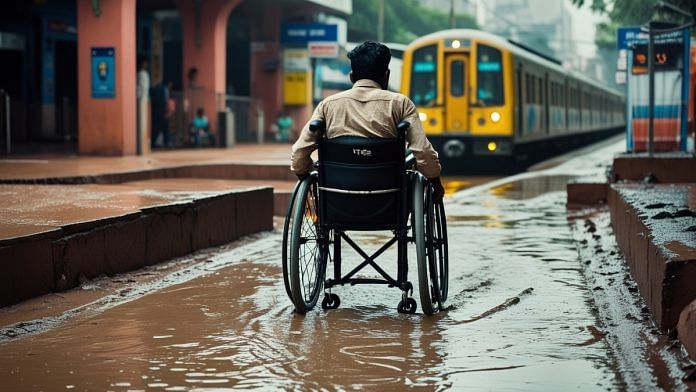Thank you dear subscribers, we are overwhelmed with your response.
Your Turn is a unique section from ThePrint featuring points of view from its subscribers. If you are a subscriber, have a point of view, please send it to us. If not, do subscribe here: https://theprint.in/subscribe/
People with disabilities (PwDs) in India often remain invisible in public discourse and urban planning, particularly in cities where accessibility is an afterthought. UNESCO estimates that 7.8 million children with disabilities in India struggle to access education due to insufficient infrastructure. The lack of ramps, accessible toilets, and educational materials like Braille books leads to high dropout rates, forcing many to abandon their dreams.
Stories:
Lalita Kumari, a 25 year old sociology graduate from Jharkhand, carries the weight of invisible barriers with each step, her journey through crowded streets, where the roar of traffic mingles with the hum of frustration, serves as a silent testimony to the city’s indifference. Her locomotor disability makes commuting a Herculean task, with public transport largely inaccessible. Her aspirations are often curtailed not by her abilities but by a society that perpetuates physical and emotional isolation.
Pratibha, a nine year old with low vision, moved to Delhi seeking better rehabilitation services. The COVID-19 pandemic exacerbated her family’s struggles, exposing the compounded difficulties of economic hardship and disability. Their story highlights the intersection of poverty and disability, a recurring theme across India.
Transportation and Infrastructure Challenges
Navigating the urban labyrinths of India is a Herculean task for PwDs, where every step is an ordeal fraught with barriers. Approximately 67% of PwDs report difficulties with public transport. While metro systems in some cities have become more accessible, the journey to and from stations remains fraught with uneven pavements and waterlogged roads. The lack of last mile connectivity amplifies their struggles.
Ten year old Mohammed Mazz, who has cerebral palsy, lives in Bangalore with his family, dependent on daily wages. The financial strain of arranging transportation for his therapy sessions highlights the critical nexus between disability and poverty.
Healthcare Gaps
India’s healthcare system poses significant challenges for PwDs, particularly in rural areas where facilities are sparse. Many disabilities could be prevented or managed with proper maternal care, yet systemic neglect and discrimination in medical settings persist. For many PwDs, accessing adequate healthcare remains a distant dream, exacerbating their physical and mental health struggles.
Shahin Parveen, a young girl with brittle bone disease, exemplifies these challenges. Her restricted mobility fosters a sense of isolation, leading to depressive episodes. Dr. Anjali Sharma, a psychologist, stresses the importance of integrating mental health into disability policies to address such cycles of exclusion effectively.
Employment Barriers
Employment opportunities for PwDs remain woefully inadequate despite mandated quotas. Discrimination in hiring and inadequate workplace accommodations often sideline talented individuals. Many organizations fail to meet legal obligations, leaving PwDs unemployed or underemployed.
A deeper dive into the roots of workplace discrimination reveals how cultural attitudes and a lack of awareness perpetuate these barriers. Flexible workplace policies and inclusive practices are essential for unlocking the potential of PwDs. Without them, societal biases continue to reinforce professional marginalization.
Policy Implementation Gaps
Government initiatives like the Accessible India Campaign were designed to bridge gaps in infrastructure and public services, but inconsistent implementation undermines their impact. While some railway stations have retrofitted ramps and tactile pathways, many remain inaccessible. Comparisons to nations like Sweden, which conducts regular accessibility audits, highlight the need for rigorous enforcement and accountability in India.
A Holistic Call for Change
The path to overcoming these entrenched challenges demands not just a comprehensive approach, but a fundamental reimagining of society’s attitudes and structures toward disability. Infrastructure development, societal attitude shifts, and robust policy enforcement must go hand in hand. Accessibility is not merely a convenience. It is a fundamental right that underscores the dignity and autonomy of PwDs.
Data collection on disability related issues is crucial for informed policymaking and resource allocation. Public awareness campaigns can foster an inclusive ethos where individuals are celebrated for their potential rather than defined by limitations. Cross sector collaboration between government bodies, private enterprises, and civil society can also catalyze meaningful progress.
Global Lessons and Local Applications
India, though uniquely positioned, could gain valuable insights from global practices. In Sweden, for instance, universal design principles have shaped urban landscapes, ensuring accessibility for all. Yet, for these models to resonate in India, they must contend with a vastly different socio political terrain one where urban poverty, caste dynamics, and the fragmentation of governance complicate the path to systemic inclusivity.
Similarly, Japan’s integrated approach to inclusive education and employment showcases how systemic inclusivity can uplift PwDs. Tailoring these models to India’s unique socio economic context could significantly enhance the lives of its disabled citizens.
Conclusion:
India’s path to inclusivity is fraught with challenges, but the journey is essential for building a fair and equitable society. By prioritizing accessibility in transportation, education, healthcare, and employment, the nation can unlock the immense potential of PwDs. Policymakers must enforce existing laws, while businesses and communities should actively promote inclusivity.
These pieces are being published as they have been received – they have not been edited/fact-checked by ThePrint


